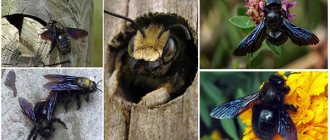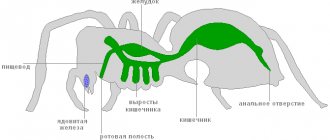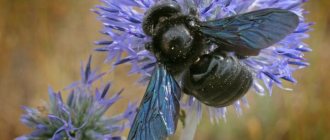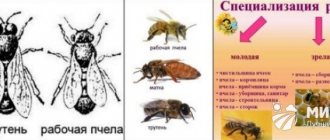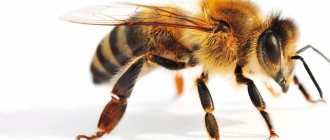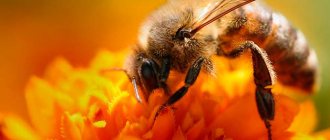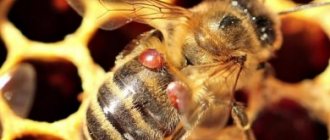Bees Blog Articles
Beekeeping
Economics of beekeeping
Beekeeping news in Russia
Beekeeping news in the world
Honey
Propolis
Bee bread
Zabrus
Royal jelly
In the world about bees
Apiary
Bees
News from honey fairs
From the history of beekeeping
- What is the structure of a bee's eyes?
- Features of the eyes of the queen, drone, worker bee
- Bee vision mechanism
- The location and number of eyes of a bee
- Why exactly so many eyes?
- Color perception of the world through the eyes of bees
- Can bees see in the dark?
- What happens if you blind a bee with a bright light?
What is the structure of a bee's eyes?
To the unusual question about how many eyes a bee has, we immediately answer: “There are only five eyes, 3 simple, and 2 complex, consisting of facets.” Bees have a complex visual system. It unites various organs of the visual apparatus, which are responsible for performing certain functions.
Such organs help bees navigate in space, compensate for insufficient illumination, and allow them to smell flowering at a distance of up to 1 km. They are not only responsible for the perception of the environment, but also perform additional functions. The working honey bee has eyes with a complex structure on the sides of its head. They are formed by a huge number of special cells. They are called facets. Bees see their surroundings as a mosaic made up of tiny particles. Each facet is responsible for forming its own part of the picture.
A few words about the senses
If we talk about a bee, then to an ordinary person many things will seem strange in its senses. They are very different from the usual view. The insect perceives odors using its antennae. Even in complete darkness, with the help of its antennae, it orients itself well in space.
The insect feels touch with the help of its legs. Drones have several times more tactile receptors than workers. Apart from the pharynx, taste buds are scattered throughout the body.
The insect hears with the help of hairs located both on the legs and on other parts of the body.
She has sense organs inaccessible to humans. Atmospheric humidity, temperature, amount of carbon dioxide. It’s hard to say what else she perceives and can analyze.
Interesting! The most amazing thing is the organs of vision.
Features of the eyes of the queen, drone, worker bee
If you compare the visual organs of bees of different classes, you will find differences. The worker bee has simple eyes located on the crown of the head. In contrast, in the drone and queen bee such organs are located directly on the forehead. Insects have different numbers of facets (ommatidia). In queen bees their number often reaches 4,000, in worker bees - 5,000, in drones - 9,000.
The compound eyes are clearly visible in drones, since they converge on the crown of the head. In the queen bee and worker bee, it is difficult to distinguish these visual organs at a superficial glance. In all the insects described, simple ocelli have a primitive structure. These are special transparent lenses; they protrude significantly from the head. Each of them separately captures images.
Bee vision mechanism
If you look closely at compound eyes using a magnifying loupe, you will notice hexagonal embossing on the surface of each organ. Because of this specific embossing, the eyes are often called mesh. Any of the facets is a bundle, which consists of cells that have an elongated shape and a thin border. Between adjacent eyes there are special pigment cells.
The presence of thousands of facets does not provide bees with good vision. Regardless of environmental conditions, the image of objects remains insufficiently clear. It is divided into separate points. The special design of the binocular system imposes its own limitations. It has been proven that the eyes of bees are more adapted to the perception of objects that are in motion, in a state of flight. Vision does not cope well with the perception of objects that are motionless and do not change their location.
The visual information that bees perceive through their eyes is instantly converted into nerve impulses. They immediately enter the brain. There, first the analysis takes place, and then the processing of the received information. After the response is generated by the central part of the nervous system, the signal is transmitted to peripheral organs. Insect vision is characterized by three-dimensionality and blurred images.
The location and number of eyes of a bee
Regardless of the class of the insect (worker bee, drone, queen bee), it has five eyes. On the head of any individual are located:
- three small dorsal ocelli (ocelli);
- two large eyes with a complex structure.
The eyes of the second type are called facet eyes because they are located on the sides of the head and are formed from a huge number of facets. Such organs of vision have an oblong shape. They are bulges that point downwards.
Compounded eyes are formed from ommatidia - these are structural units. They are densely located, neighboring ommatidia are closely adjacent to each other. Each of these functional units that make up the facet organ has a refractive, insulating and receptive part.
Interestingly, the size of each honey bee eye is on average 2 millimeters. Moreover, the number of eyes remains unchanged for each individual. The visual organs of drones have the most significant area; the second place according to this criterion is occupied by working individuals, and the uterus closes the list.
Why exactly so many eyes?
Hardworking bees initially have a poorly developed visual apparatus. To compensate for their underdeveloped vision, nature has endowed them with several organs of vision. As many as five eyes allow these insects to navigate their surroundings, receive information about flowering plants, and see various objects. Large eyes help to see objects and form a holistic picture of what is happening around the insect.
The dorsal organs (ocelli) are responsible for twilight vision. They help bees learn about the approach of dawn and the onset of a new day, as well as accurately receive information about its end. Ocelli partially replace the sense of touch; they have a secondary function as part of the binocular system. The facet organs form images in the form of a mosaic, which consists of individual points and helps to obtain a holistic view of objects.
Compounded eyes with a complex structure are used as the main part of the visual apparatus. In contrast, simple eyes are considered a secondary element. They provide bees with objective information about the surrounding space.
Why do bees have 5 eyes?
From the above information, we can conclude that bee eyes are divided into two main types. Both types have different purposes and devices:
- The three small visual organs are simple transparent lenses that protrude from the chitinous layer of the head. The images are captured in each of them, but have some differences, like adjacent frames of photographic film that are taken from different angles. The image is processed in the insect's brain, then giving a clear idea of surrounding objects located at a short distance. In addition, three small eyes are necessary for the insect to navigate well in cramped and dark spaces, as well as on flowers while collecting pollen.
- Two large oval-shaped eyes differ from three small ones in a more complex structure. Their surface is not smooth. It consists of many small fragments, the shape of which is similar to the shape of a honeycomb. Each fragment is a separate miniature eye or facet that is capable of capturing only small fragments of images. To get a complete picture of the surrounding objects, the picture is assembled in the insect’s brain from many small fragments, like a mosaic. Such vision cannot be called clear, but it is large-scale and voluminous. This allows the bee to look at a wide area while flying.
It is worth noting that it is no coincidence that nature has endowed honey bees with two different types of eyes . With such extraordinary vision, simple and complex visual organs complement each other to make the overall picture clearer, more complete and more realistic.
Color perception of the world through the eyes of bees
Such insects distinguish many colors and shades. Only they do not perceive the color red, they cannot distinguish it from black. By the way, this is why all winter inspections of bees are carried out using a red flashlight; bees do not see light, which means they are less worried. Bees' images of the surrounding world are formed in the ultraviolet spectrum.
Simple
Front view
What role these vision organs play has not yet been precisely established. Although there are a number of theories that they play an auxiliary role in perceiving the intensity of light, signaling the onset of dawn and dusk. In general, they are similar to the principle of operation of a camera.
That is, just as images appear on a photographic plate, they themselves reproduce certain objects that are the result of the action of fairly branched nerve endings. What is characteristic is that the individual images in the three eyes merge into one, due to which the simultaneous view of space increases. That is, such panoramic photography.
Compared to other insects, bees have good color vision. The famous Austrian biologist K. Frisch conducted a large number of experiments, the results of which allow us to imagine how insects distinguish the color scheme of the surrounding space. They found that they could best distinguish objects of blue, yellow, orange, green, and white colors. They do not distinguish the color red. Whether it’s gray, whether it’s black, or whether it’s red, they are all the same for insects. They also have a developed ability to respond to polarized light, which is emitted, for example, by the blueness of the sky.
The queen bee, or as she is also called the queen, queen, as well as the worker bee, has five eyes - 2 complex and 3 simple. Drones have the same number of vision organs.
Video: This is how bees see
Adults perceive shades of white, blue and yellow best. The vision of adults can be called mosaic. Their brains do a lot of work when forming an image. The whole process looks like this:
- Each of thousands of facets perceives only one part of an object, and not the entire object.
- The brain processes incoming images depicting individual parts of an object.
- In the brain, individual parts of an object merge, and as a result, worker bees perceive the whole picture.
Bees do not see much difference between orange, green, light green and yellow colors. The visual apparatus of bees has the ability to perceive polarized light. This quality allows insects to calmly navigate in space.
Video: A look at the apiary through the eyes of a bee
It is worth noting that worker bees rarely fly in the dark, with rare exceptions. This is caused not only by the need for night rest, but also by a decrease in the strength of the electromagnetic field. This factor contributes to the disruption of spatial orientation in bees, so they generally prefer not to fly at night. Experimentally, it was possible to find out that these insects are able to distinguish the shapes of objects.
What happens if you blind a bee with a bright light?
If a bee flying by is blinded by a flash of bright and directional light, then it will simply fall and lose orientation. Such an experiment will greatly harm the insect, which brings significant benefits. So don't blind the bee. Her visual organs are not able to process light that is too bright and strong. A blinded, stunned worker bee does not immediately recover from exposure to a flash of light. She takes off after a certain time to continue her journey.
Recent studies have established myopia of the facet organs of honey bees. These hard workers clearly see objects that are at close range. The further away an object is, the more difficult it is for bees to see it in detail and form their own idea of it. At a distance exceeding 50 cm, insects notice only those objects that move. Honeybees see best at a distance of a few centimeters.
Latest added articles about bees and beekeeping:
For many years, scientists have been interested in the question of how such a small insect as a bee is able to travel long distances in search of flowering fields and gardens, finding them, and how many colors they can distinguish. The whole secret and answer lies in the unusualness of their vision. Next, we will consider the visual features of these small flying creatures.
